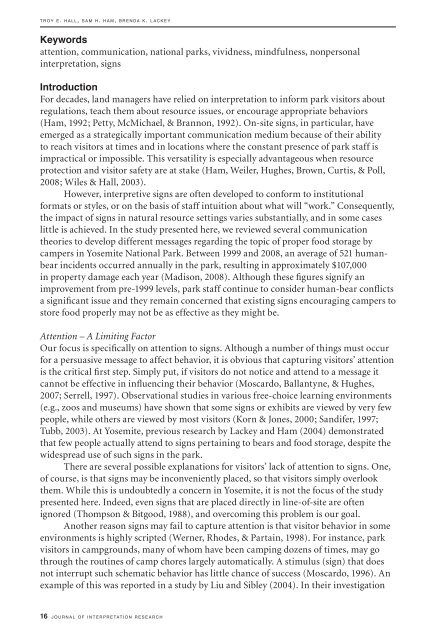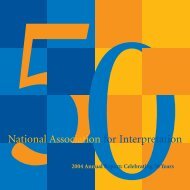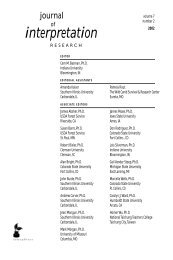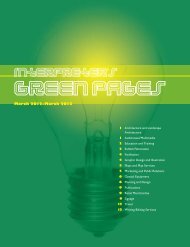interpretation
Volume 15, Number 1 - National Association for Interpretation
Volume 15, Number 1 - National Association for Interpretation
Create successful ePaper yourself
Turn your PDF publications into a flip-book with our unique Google optimized e-Paper software.
t r o y e. h a l l , s a m h. h a m , b r e n d a k. l a c k e y<br />
Keywords<br />
attention, communication, national parks, vividness, mindfulness, nonpersonal<br />
<strong>interpretation</strong>, signs<br />
Introduction<br />
For decades, land managers have relied on <strong>interpretation</strong> to inform park visitors about<br />
regulations, teach them about resource issues, or encourage appropriate behaviors<br />
(Ham, 1992; Petty, McMichael, & Brannon, 1992). On-site signs, in particular, have<br />
emerged as a strategically important communication medium because of their ability<br />
to reach visitors at times and in locations where the constant presence of park staff is<br />
impractical or impossible. This versatility is especially advantageous when resource<br />
protection and visitor safety are at stake (Ham, Weiler, Hughes, Brown, Curtis, & Poll,<br />
2008; Wiles & Hall, 2003).<br />
However, interpretive signs are often developed to conform to institutional<br />
formats or styles, or on the basis of staff intuition about what will “work.” Consequently,<br />
the impact of signs in natural resource settings varies substantially, and in some cases<br />
little is achieved. In the study presented here, we reviewed several communication<br />
theories to develop different messages regarding the topic of proper food storage by<br />
campers in Yosemite National Park. Between 1999 and 2008, an average of 521 humanbear<br />
incidents occurred annually in the park, resulting in approximately $107,000<br />
in property damage each year (Madison, 2008). Although these figures signify an<br />
improvement from pre-1999 levels, park staff continue to consider human-bear conflicts<br />
a significant issue and they remain concerned that existing signs encouraging campers to<br />
store food properly may not be as effective as they might be.<br />
Attention – A Limiting Factor<br />
Our focus is specifically on attention to signs. Although a number of things must occur<br />
for a persuasive message to affect behavior, it is obvious that capturing visitors’ attention<br />
is the critical first step. Simply put, if visitors do not notice and attend to a message it<br />
cannot be effective in influencing their behavior (Moscardo, Ballantyne, & Hughes,<br />
2007; Serrell, 1997). Observational studies in various free-choice learning environments<br />
(e.g., zoos and museums) have shown that some signs or exhibits are viewed by very few<br />
people, while others are viewed by most visitors (Korn & Jones, 2000; Sandifer, 1997;<br />
Tubb, 2003). At Yosemite, previous research by Lackey and Ham (2004) demonstrated<br />
that few people actually attend to signs pertaining to bears and food storage, despite the<br />
widespread use of such signs in the park.<br />
There are several possible explanations for visitors’ lack of attention to signs. One,<br />
of course, is that signs may be inconveniently placed, so that visitors simply overlook<br />
them. While this is undoubtedly a concern in Yosemite, it is not the focus of the study<br />
presented here. Indeed, even signs that are placed directly in line-of-site are often<br />
ignored (Thompson & Bitgood, 1988), and overcoming this problem is our goal.<br />
Another reason signs may fail to capture attention is that visitor behavior in some<br />
environments is highly scripted (Werner, Rhodes, & Partain, 1998). For instance, park<br />
visitors in campgrounds, many of whom have been camping dozens of times, may go<br />
through the routines of camp chores largely automatically. A stimulus (sign) that does<br />
not interrupt such schematic behavior has little chance of success (Moscardo, 1996). An<br />
example of this was reported in a study by Liu and Sibley (2004). In their investigation<br />
16 j o u r n a l o f i n t e r p r e t a t i o n r e s e a r c h












